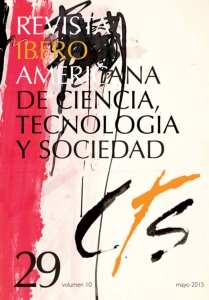The teaching training college and the perception of ICT availability
Comparative study: the UAEM-BUAP case
DOI:
https://doi.org/10.52712/issn.1850-0013-522Keywords:
universities, ICT, perceptions, comparative studyAbstract
ICT access and availability have been regarded differently depending on the university; for some this has meant a great deficit, for others it has not constituted a problem. The aim of this paper is to present the prevailing situation as to the perception teachers have regarding the availability to Information and Communication Technologies (ICT) in two state-owned institutions: the UAEM and the BUAP. The implemented research method was correlational, ex post facto, through a questionnaire that had been previously designed, validated and standardized, in order to offer a comparative diagnosis regarding perception. Its results convey, among other conclusions, that: a) regarding ICT availability for academic activities, the university context influences the professors’ perception; b) the ICT-availability-for-teaching factor is considered deficient in both universities; c) connectivity is perceived as good in BUAP and deficient at UAEM; and d) technological equipment availability is perceived as deficient at UAEM, and as adequate at BUAP.
Downloads
References
BARONA, C., PETRIZ, M., TORRES, A., ZÚÑIGA, O. y SOBERANES, Y. (2012): “Actitudes y expectativas de los profesores de tiempo completo de la UAEM en torno a las Tecnologías de Información y Comunicación”, en A. Torres y C. Barona (coords.): Los profesores universitarios y las TIC. Uso, apropiación, experiencias. México, Juan Pablos Editor, pp. 83-102.
BILBAO-OSORIO, B. y PEDRÓ, F. (2009): “A conceptual framework for benchmarking the use and assessing the impact of digital learning resources in school education”, en F. Scheuermann y F. Pedró (eds.): Assessing the effects of ICT in education: Indicators and benchmarks for international comparisons, Luxemburgo, European Union y OECD, pp. 107-120.
CEPAL (2003): Los caminos hacia una sociedad de la información en América Latina y el Caribe, Santiago de Chile, CEPAL/ECLAC. Disponible en: http://www.eclac.cl/publicaciones/xml/9/12899/lcg2195e2.pdf.
CLARO, M. (2010): Impacto de las TIC en los aprendizajes de los estudiantes. Estado del arte, Santiago de Chile, CEPAL/Unión Europea. Disponible en: http://www.eclac.org/publicaciones/xml/7/40947/dp-impacto-tics-aprendizaje.pdf.
CRESWELL, J. (2002): Educational Research. Planning, Conductiong and Evaluating Quantitative and Qualitative Research, Editorial Merril Prentice Hall.
CROVI, D. (2009): Acceso, Uso y Apropiación de las TIC en comunidades académicas. Diagnóstico en la UNAM, México, Universidad Nacional Autónoma de México/Plaza y Valdés Editores.
DÍAZ, J., PÉREZ, A y FLORIDO, R. (2011): “Impacto de las Tecnologías de la Información y las Comunicaciones (TIC) para disminuir la brecha digital en la sociedad actual”, Cultivos Tropicales, vol. 32, n0 1, pp. 5-10. Disponible en: http://www.redalyc.org/articulo.oa?id=193222352001.
KERLINGER, F. (1975): Investigación del comportamiento: técnicas y metodología, México, Nueva Editorial Interamericana.
KIKIS, K., SCHEUERMANN, F y VILLALBA, E. (2009): “A framework for understanding and evaluating the impact of information and communication technologies in education”, en F. Scheuermann y F. Pedró (eds.): Assessing the effects of ICT in education: Indicators and benchmarks for international comparisons, Luxemburgo, European Union y OECD, pp.69-82.
TAPIA, C. (2012): Infraestructura tecnológica y apropiación de las TIC en la Benemérita Universidad Autónoma de Puebla. Estudio de caso, Avance de Tesis de Doctorado (inédito), México, Posgrado ICE-UAEM.
PASTOR, C. (2005): “Presentación Monográfico el Profesorado Universitario y las TIC en el Proceso de Convergencia Europea”, Revista de Educación, vol. 337, pp. 7-11. Disponible en http://www.revistaeducacion.mec.es/re337/re337.pdf.
TORRES, S., BARONA, C., ALARCÓN, T., GARCÍA, O y RUIZ, D. (2012): “Formación de profesores universitarios en el uso de las TIC para la investigación”, en C. Leite e M. Zabalza (coords.): Ensino Superior: Inovação e qualida de na docência, CIIE–Centro de Investigação e Intervenção Educativas, Universidad do Porto, pp. 3470-3486.
TORRES, S., BARONA, C y GARCÍA, O. (2010): “Infraestructura tecnológica y apropiación de las TIC en la Universidad Autónoma del Estado de Morelos. Estudio de caso”, Revista Perfiles Educativos, vol. 32, nº 127, pp.105-127. Disponible en: http://www.scielo.org.mx/pdf/peredu/v32n127/v32n127a6.pdf.
TORRES, S y BARONA, C. (2012): “Las TIC en el contexto de una universidad pública estatal: estudio de caso”, en S. Torres y C. Barona (coords.): Los profesores universitarios y las TIC. Uso, apropiación, experiencias, México, Juan Pablos Editor, pp.19-42.
TORRES, S., TAPIA, C., BARONA, C y GARCÍA, O. (2012): “Análisis de las dimensiones teórico-metodológicas de aplicación de las TIC por parte de los académicos de la Benemérita Universidad Autónoma de Puebla (BUAP)”. Disponible en: http://www.google.com.mx/url?sa=t&rct=j&q=&esrc=s&source=web&cd=1&ved= 0CCkQFjAA&url=http%3A%2F%2Fwww.virtualeduca.info%2Fponencias2011%2F14 4%2FPONENCIA_ANGEL_VIRTUALEDUCA_011[1].doc&ei=Iu2DUvTBA6fO2gXTioH gBA&usg=AFQjCNHyqBe8I_YhAXjUZnTMWX316aNGWA&bvm=bv.56343320,d.b2I.
UAEM (2013): Primer Informe de Actividades 2012-2013. Disponible en: http://www.uaem.mx/organizacion-institucional/rectoria/primer-informe-2012-2013.
UIS-UNESCO (2007): Institute for Statistics initiatives for standardization of Information and Communication Technologies (ICT) use in Education indicators, Río de Janeiro, UNESCO, Institute for Statistics. Disponible en: http://www.eclac.cl/socinfo /noticias/paginas/0/35880/UISICTEducationIndicators_Apr2009.pdf.
Downloads
Published
How to Cite
Issue
Section
License
Copyright (c) 2023 CC Attribution 4.0

This work is licensed under a Creative Commons Attribution 4.0 International License.
All CTS's issues and academic articles are under a CC-BY license.
Since 2007, CTS has provided open and free access to all its contents, including the complete archive of its quarterly edition and the different products presented in its electronic platform. This decision is based on the belief that offering free access to published materials helps to build a greater and better exchange of knowledge.
In turn, for the quarterly edition, CTS allows institutional and thematic repositories, as well as personal web pages, to self-archive articles in their post-print or editorial version, immediately after the publication of the final version of each issue and under the condition that a link to the original source will be incorporated into the self-archive.











